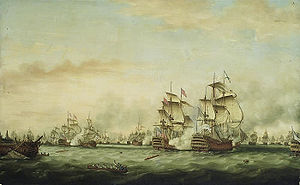French ship Ville de Paris (1764)
| 40px | This article is missing citations or needs footnotes. Please help add inline citations to guard against copyright violations and factual inaccuracies. (October 2007) |
| |
This article does not cite any references or sources. Please help improve this article by adding citations to reliable sources. Unsourced material may be challenged and removed. (October 2007) |
 The Battle of the Saintes, 12 April 1782: surrender of the Ville de Paris by Thomas Whitcombe, painted 1783, shows Hood's Barfleur, centre, attacking the French flagship Ville de Paris, right. | |
| Career (France) | |
|---|---|
| Namesake: | Paris |
| Ordered: | as Impétueux |
| Builder: | Rochefort harbour |
| Laid down: | 1757 |
| Commissioned: | 1764 |
| Renamed: | Ville de Paris in 1762 |
| Fate: | sank September 1782 |
| General characteristics | |
| Class and type: | 1st rate ship of the line |
| Length: | 54 m |
| Beam: | 14.6 m |
| Draught: | 6.7 m |
| Propulsion: | Sail |
| Armament: |
90-gun: 32-24-pounders, 28-12-pounders. 14-8 pounders added in 1779, making her a 104-gun |
| Armour: | Timber |
The Ville de Paris was a large three-decker French ship of the line that became famous as the flagship of the Comte de Grasse during the American War of Independence.
Originally laid down in 1757 as the 90-gun Impétueux, she was renamed Ville de Paris in 1762 as a result of the Duc de Choiseul’s campaign to raise funds for the navy from the cities and provinces of France.
She was completed in 1764 as a 90-gun First Rate, just too late to serve in the Seven Years' War. She was one of the first three-deckers to be completed for the French navy since the 1720s.
In 1778, on the French entry into the American War of Independence she was commissioned at Brest, joining the fleet as the flagship of the Comte de Guichen. In July she fought in the indecisive Battle of Ushant (1778).
At some point during the next two years, she had an additional 14 small guns mounted on her previously unarmed quarterdeck, making her a 104-gun ship.
In March 1781 she sailed for the West Indies as flagship of a fleet of 20 of the line under the Comte de Grasse. She then fought at the Battle of Fort Royal, the Battle of the Chesapeake and the Battle of St. Kitts as De Grasse's flagship.
She was taken at the Battle of the Saintes on 12 April 1782, when the British fleet under Admiral Sir George Rodney defeated the French fleet under the Comte de Grasse.
Tragically, the ship did not live up to the motto of her namesake city, Fluctuat nec mergitur (Latin: Tossed by the waves, she does not sink), for she sank in September 1782 with other ships when a fleet led by Admiral Graves was hit by a hurricane off Newfoundland on the voyage back to England. The Ville de Paris sank with the loss of all hands but one.
A ship of the line of the Royal Navy was named after her: HMS Ville de Paris, launched in 1795.
- Pages with broken file links
- Articles with unsourced statements from October 2007
- Articles with invalid date parameter in template
- All articles with unsourced statements
- Articles lacking sources from October 2007
- All articles lacking sources
- French Navy ships of the line
- Shipwrecks in the Atlantic Ocean
- Maritime incidents in 1782
